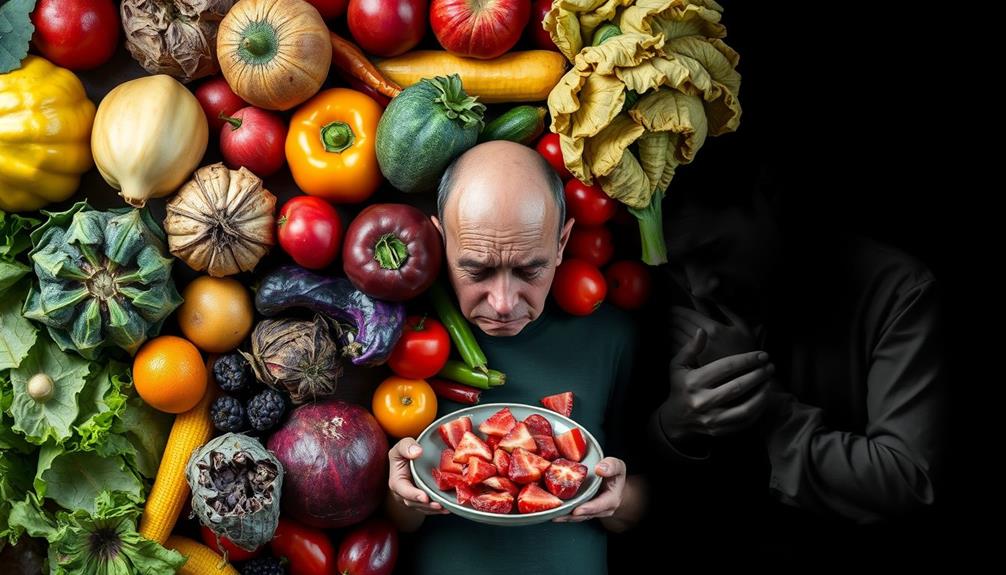Animals can safely eat raw food because their digestive systems are specially adapted to handle it. They have stronger stomach acids and unique enzymes that break down bacteria and parasites effectively. In contrast, when you try to consume raw meat, you face serious health risks like foodborne illnesses from harmful bacteria such as E. coli and Salmonella. Your immune system isn't as robust against these pathogens, leading to potential deficiencies and severe illnesses. Furthermore, cooking enhances nutrient absorption and makes food safer, reflecting how evolution shaped human diets. There's much more to explore about this fascinating topic.
Key Takeaways
- Animals have evolved stronger stomach acids and unique digestive systems that allow them to handle bacteria and pathogens found in raw food.
- Humans lack the digestive adaptations present in carnivorous animals, making them more susceptible to foodborne illnesses from raw meat.
- Cooking meat enhances nutrient absorption for humans, as it breaks down muscle fibers and makes nutrients more bioavailable.
- The historical reliance on cooking has shaped human diets, improving health and reducing the risks associated with consuming raw food.
- Proper cooking significantly reduces harmful microorganisms, ensuring food safety and preventing severe illnesses linked to raw meat consumption.
Animal Digestive Adaptations
Animal digestive adaptations are fascinating examples of evolution at work. When you look at carnivores, it's clear they're built to eat raw meat. Their stomachs contain stronger acids and specialized enzymes, enabling them to break down meat efficiently while extracting essential nutrients. This unique digestive system allows them to handle bacteria and parasites that would pose significant risks to humans.
Additionally, just as with cold medications, the specific adaptations in these animals help them effectively process their natural diets while preventing illness.
You might wonder how these animals manage food safety. By consuming their prey immediately after killing it, they minimize the risk of bacterial growth and contamination that can occur after death. Their immune systems have also evolved to combat a wide range of pathogens, giving them a remarkable resistance to foodborne illnesses.
In contrast, the human digestive system has adapted over time to favor cooked foods. This shift signifies a significant change in human evolution, moving away from raw meat consumption.
While we've developed different strategies for handling bacteria and parasites, our digestive systems simply aren't equipped to deal with raw meat like carnivorous animals can. Understanding these adaptations highlights the profound differences in dietary needs and capabilities between species.
Risks of Raw Meat for Humans

When you consider eating raw meat, you need to be aware of the serious pathogen risks involved. Harmful bacteria like E. coli and Salmonella can thrive in uncooked meat, putting your health at risk.
Additionally, your body mightn't absorb nutrients from raw meat as efficiently as animals do, making it a risky choice for nutrition. This is akin to the importance of having a well-structured budget in managing your health and finances, as both require careful planning and awareness of risks.
Moreover, understanding common financial terms can aid in making informed decisions about your dietary choices as well.
Pathogen Risks Explained
Eating raw meat poses significant pathogen risks for humans, largely due to the harmful bacteria it can harbor. When you consume raw or undercooked meat, you increase your chances of contracting diseases like E. coli, Salmonella, and Listeria. The CDC estimates that foodborne illnesses, often linked to raw meat, cause about 500,000 deaths worldwide each year.
Additionally, similar to how individuals with BPD experience heightened emotional responses, humans have a less robust immune response to the pathogens in raw meat, making them more susceptible to illness. Your digestive system isn't built to handle the pathogens found in raw meat. Unlike carnivorous animals that have evolved stronger stomach acids and immune defenses, humans can't efficiently eliminate these harmful bacteria.
Consuming undercooked meat can lead to severe illnesses such as trichinellosis, which brings symptoms like abdominal pain, diarrhea, and fever. Moreover, there's the risk of Mad Cow Disease (BSE), which can be transmitted to humans and result in variant Creutzfeldt-Jakob disease. This disease has a long incubation period, making it difficult to detect until it's too late.
Consequently, while some animals thrive on raw diets, the risks associated with raw meat consumption for humans are serious and can lead to significant health consequences.
Nutritional Absorption Differences
The human digestive system is simply not equipped to handle raw meat as efficiently as that of carnivorous animals. When you consider how your body processes food, it's clear that cooking meat plays a crucial role in enhancing nutritional absorption. Cooking breaks down muscle fibers, making essential nutrients more accessible.
Additionally, just as with proper hamster care, the right preparation of food can greatly impact health. If you were to rely on raw meat, you might face several risks, including:
- Lower nutrient absorption: Your digestive tract struggles to extract nutrients effectively from raw meat.
- Nutritional deficiencies: Regular consumption of raw meat can lead to imbalances, similar to those observed in dogs.
- Increased energy expenditure: Your body spends more energy digesting raw meat, which could impact overall energy levels.
- Potential for imbalances: Just like dogs, humans eat raw meat at their own peril, risking nutritional health.
- Historical context: Early humans thrived after shifting to cooked diets, supporting brain development and overall health.
In essence, while some animals can thrive on raw meat, your body's evolution underscores the importance of cooking meat to maximize nutritional absorption and maintain a balanced diet.
Cooking and Food Safety

Throughout history, cooking has played an essential role in food safety by greatly reducing harmful microorganisms found in raw meat, such as E. coli and Salmonella. When you thoroughly cook meat, you eliminate the risk of foodborne illnesses, which contribute to approximately 500,000 deaths globally each year. These pathogens thrive in raw meat, making it unsafe for human consumption.
Additionally, just as early detection methods like mammography aims to detect breast cancer early for better treatment outcomes, cooking also serves as a preventive measure against health risks associated with raw meat.
Modern food safety guidelines emphasize the importance of cooking meat to safe temperatures to prevent severe health issues. It's imperative to properly treat and store meat, as spoilage begins shortly after an animal's death, increasing health risks. By cooking, not only do you kill harmful microorganisms, but you also enhance nutrient absorption. Cooking breaks down muscle fibers, making the food safer and more nutritious for you.
Incorporating cooking into your food preparation is essential for protecting yourself and your loved ones from potential dangers associated with raw meat. By prioritizing food safety, you guarantee a healthier diet, allowing you to enjoy your meals without the worry of foodborne illnesses.
Evolution of Human Diets

As you explore the evolution of human diets, you'll notice how our digestive systems adapted to a cooked, rather than raw, diet.
Cooking not only improved nutrient absorption but also played a key role in our historical dietary practices and overall health.
Notably, just as essential oils in aromatherapy can enhance our well-being, the cooking process has allowed us to access a wider array of nutrients importance of carrier oils.
Understanding these changes helps you appreciate how our food choices have shaped who we're today.
Digestive System Adaptations
In understanding digestive system adaptations, it's clear that humans have evolved considerably from their raw-food ancestors. Your digestive system has developed to thrive on cooked diets rather than raw meat, reflecting significant genetic adaptations. These changes enhance nutrient absorption and safety in food consumption.
Additionally, the introduction of cooking may have parallels with modern dietary practices, such as juice diets, which emphasize nutrient extraction and ease of digestion.
Consider these key adaptations:
- Shorter intestines: Evolved to conserve energy for cognitive functions rather than digesting raw food.
- Less acidic stomach: Unlike carnivores, your stomach environment isn't as effective at neutralizing bacteria and parasites in raw meat.
- Cooking benefits: Cooking reduces harmful pathogens and breaks down muscle fibers, making nutrients more accessible.
- Enhanced efficiency: The shift from raw to cooked diets led to improved digestive efficiency and overall health.
- Biological changes: Historical reliance on cooking has shaped human biology, allowing for better adaptation to a diverse diet.
These adaptations highlight why your body is designed for cooked diets. While animals can easily process raw food, your evolutionary path has prioritized safety and nutrient absorption over the challenges posed by raw meat.
Cooking and Nutrition
Cooking has fundamentally transformed human nutrition, allowing you to access a wider array of nutrients from your food. Unlike many animals, you can't eat raw meat without considerable risks. Cooking not only improves the taste and texture of food but also enhances nutrient absorption by breaking down muscle fibers and making it easier for your body to extract energy. This process is essential, especially since your larger brain demands more energy.
Additionally, a balanced diet rich in fruits, vegetables, and whole grains can complement the benefits of cooked foods, promoting overall health and longevity, as emphasized in lifestyle for longevity.
Moreover, cooking effectively eliminates harmful microorganisms often found in raw meat, greatly reducing the risk of foodborne illnesses. This adaptation has played a significant role in supporting human health and survival. Genetic evidence suggests that as humans evolved, our bodies became better suited to metabolize cooked foods, which provided energy-dense options critical for brain development.
The shift from raw to cooked diets has allowed you to thrive in diverse environments, ensuring that you can meet your nutritional needs while minimizing health risks. It's clear that cooking isn't just a method of preparing food; it's a fundamental aspect of human evolution that has shaped your diet and overall well-being.
Historical Dietary Practices
Throughout history, human diets have undergone significant transformations, shaped by environmental changes and advancements in food preparation techniques. Early humans, like Homo antecessor, thrived on a diet rich in raw meat and animal protein, reflecting the philosophical exploration of existence and survival.
However, the discovery of cooking revolutionized how you consume food and absorb nutrients. This pivotal shift not only enhanced nutrient absorption but also spurred brain growth and development.
Consider these key aspects of historical dietary practices:
- Raw Meat Consumption: Early humans relied heavily on raw meat before cooking methods emerged.
- Advent of Cooking: The use of fire made energy-dense foods more accessible.
- Cultural Examples: Certain cultures, like the Inuit and Maasai, still include raw meat in their diets, using specific handling techniques.
- Digestive Evolution: Shifts from raw to cooked diets led to adaptations in human digestive systems.
- Social Dynamics: Communal cooking fostered social connections and psychological development.
This evolution underscores how cooking not only shaped your diet but also influenced the very fabric of early human societies.
Cultural Practices and Raw Meat

Raw meat consumption is deeply rooted in the cultural practices of various societies, showcasing how traditions shape dietary habits. For instance, the Inuit and Maasai have historically included raw seafood and animal blood in their traditional diets, making eating raw meat a common practice.
These cultural norms influence perceptions of safety, with some communities viewing raw meat as a delicacy while others avoid it due to health risks. The power of imagination can also play a role, as individuals in these cultures envision the benefits of their traditional diets, leading to a more profound acceptance of raw food enhances creativity.
In these cultures, long-term exposure to raw meat has fostered specific handling and preparation methods that help minimize potential health risks. By developing these techniques, people in these communities have adapted to their environments and dietary needs over generations.
This adaptation often ties back to historical survival strategies, as consuming raw meat provided essential nutrients when other food sources were scarce.
Moreover, the acceptance of raw meat is often connected to specific immune responses that some populations have developed against pathogens common in their diets. As a result, cultural practices surrounding raw meat consumption not only reflect dietary preferences but also highlight the intricate relationship between tradition, survival, and health in different societies.
Immune System Differences

Understanding immune system differences between animals and humans reveals essential insights into our dietary choices.
Animals, especially carnivores, have evolved to consume raw meat, thanks to their robust stomach acids and specialized digestive enzymes. These adaptations allow them to break down raw meat effectively and neutralize harmful pathogens that humans might struggle with.
In contrast, your immune system isn't designed to handle the same level of bacteria and parasites found in raw meat.
Here are some key differences:
- Carnivores possess stronger stomach acids.
- Their immune systems tolerate raw meat bacteria better.
- Humans evolved to rely on cooked foods for safety.
- Cooking considerably reduces the risk of foodborne illnesses.
- Human digestive systems prioritize nutrient absorption from cooked sources.
As a result, humans face higher hospitalization rates related to foodborne illnesses, especially in cultures that consume raw meat.
Our evolutionary shift towards cooking highlights the importance of preparing food safely, ensuring you not only avoid risks but also maximize nutrient absorption.
Embracing cooked foods is essential for your health and well-being.
Frequently Asked Questions
Why Can Animals Eat Raw Meat but Humans Can't?
Animals can eat raw meat because their stomachs and digestive systems are designed for it. They've got stronger acids and enzymes, plus immune systems that handle pathogens better than yours, which makes it safer for them. When it comes to feeding animals a raw food diet, it’s important to focus on the basics. This includes a balanced mix of muscle meat, organ meat, bones, and some fruits and vegetables. By adhering to these raw food diet basics, pet owners can ensure that their animals receive all the necessary nutrients and minerals for a healthy and balanced diet. It’s also important to consult with a veterinarian to ensure that the raw food diet is appropriate for the specific needs of each individual animal.
Why Did Humans Lose the Ability to Eat Raw Meat?
You've lost the ability to eat raw meat because your digestive system evolved to process cooked food more efficiently. Cooking kills harmful pathogens and aids nutrient absorption, making it safer and more beneficial for your health.
Why Can Lions Eat Raw Meat but We Cant?
Lions can eat raw meat because their stomachs are highly acidic and equipped with specialized enzymes. Their shorter digestive tracts allow for quick processing, minimizing bacterial growth, unlike humans who need to cook for safety.
Why Can Cats Eat Raw Chicken but Humans Can't?
You might notice that cats thrive on raw chicken because their digestive systems are designed for it. Their shorter tracts and stronger stomach acid allow them to digest raw meat safely, unlike your own.
Conclusion
In the grand tapestry of life, you might say animals enjoy a raw culinary adventure that humans simply aren't equipped for. While your body thrives on cooked delights, it's all about evolution and those clever adaptations. Embracing the warmth of cooked food not only enhances flavor but also keeps you safe. So, next time you savor a meal, remember—it's not just about taste; it's a delightful dance between nature and nurture, ensuring your health takes center stage.










